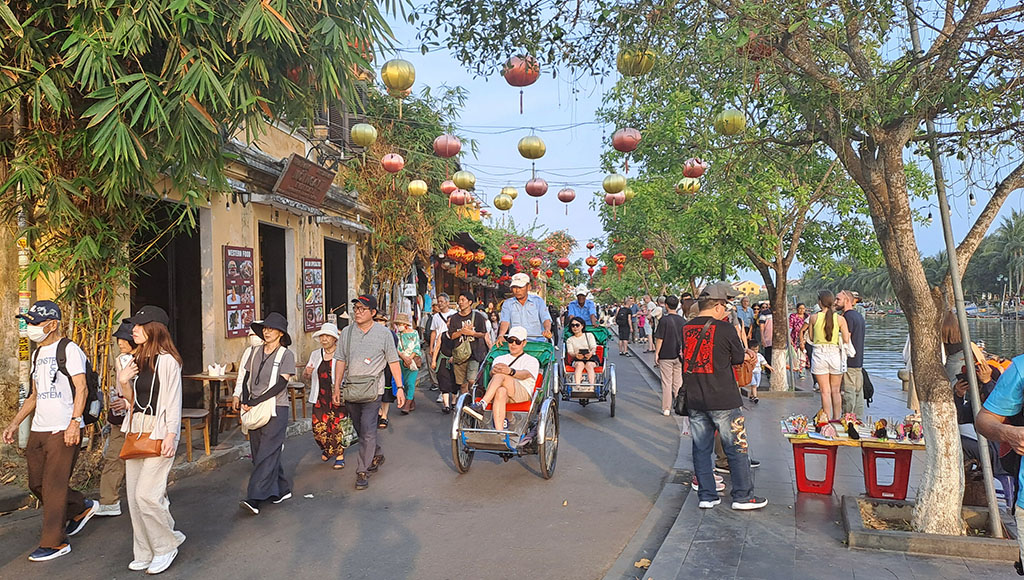The receptionist said “turn left outside the hotel and follow the crowds. You’ll soon find the centre of all the action in Hôi An, it’s down by the river. I am sure that you won’t want to return until later this evening”. She was right.
It was weekend and this charming old trading city was thronged with local Vietnamese as well as foreign tourists. We sipped ice cold beers at a café by the river, people watched and reflected on what had already been an interesting day.
We had left the ancient capital city of Hué early in the morning and driven up into the hills by the ocean, over the Hai Van Pass and down to the rapidly expanding coastal resort of Danang. Sadly, the views from the pass were limited due to low cloud.

After a ‘compulsory’ tourist stop in Danang to view Buddhas being carved from decorative marble, we arrived in Hôi An and immediately fell in love with its narrow streets, gorgeous old wooden houses and hundreds of shops. We were soon tempted to buy silk scarves, blouses and T-shirts for folk back home. There was a great choice and at reasonable prices.

And later by the river, we finished our beers and wandered slowly around the quayside, doing our utmost to avoid the crazy rickshaw drivers, who were racing each other down narrow streets, carrying corpulent western tourists. There were coloured Chinese lanterns everywhere.
Chattering locals were enjoying boat trips, gobbling down fast food, buying trinkets off the street sellers and taking selfies (a Vietnamese obsession). It really was party time and dusk was approaching. As night fell, the whole of Hôi An became quite magical, as all the Chinese lanterns were lit. Tourists lit their own candle lanterns, jumped into the boats and the whole river was turned into an unforgettable wonderland of coloured lights. Having wallowed in the ambience of this almost mythical environment, we dined overlooking the river and strolled happily back to our hotel. We had fallen in love with Hôi An!
Old Town Hội An, the city’s historic district, is recognized as a well-preserved example of a Southeast Asian trading port dating from the 15th to the 19th century, its buildings and street plan reflecting a blend of indigenous and foreign influences. The Portuguese sailors of this era will have known this city well and the early Portuguese Jesuit missionaries had a residence here.
The following day, we explored more of the many back streets, looked at beautiful Buddhist temples and admired some of the original wooden premises. The Museum of Folk Culture, situated in a splendid old building, had some fascinating displays of equipment originally used for agriculture and fishing, most of which seemed to be made from bamboo. Hôi An really does have something for everyone.
It was time to continue our Vietnamese journey by air to the south of the country and to the Mekong Delta. Can Tho, in the south of the Delta, was our destination and this charming city lies in a picturesque setting on the banks of the Hau River, a tributary of the Mekong. It is the fourth largest city in Vietnam with a population of over a million. It is famous for its floating markets, rural canals, traditional crafts and huge quantities of waste plastic floating in its waterways!
Our day began at dawn with a sampan ride to see the largest floating market in the Mekong Delta. We witnessed a seemingly chaotic display of trade, mainly in fruit and vegetables between large and small boats. In practice of course, it was extremely well organized!

We moved on to visit a fruit orchard, criss-crossed with little canals where we saw the cultivation of a wide range of delicious tropical fruits, such as pomelo (like a giant grapefruit), massive jack fruit, mango, guava, dragon fruit, mangosteen and the very stinky durian! Even better, this was followed by a tasting of each!
Then our boat threaded its way through more plastic waste down a narrow canal to visit one of the last of the city’s basket makers. We were amazed at the skills of this elderly gentleman and his wife as they split bamboo and weaved it artistically into surprisingly robust baskets.
A joyous afternoon, in searing heat and humidity, was spent at Son Islet, a short boat ride across the river. Here, ushered by two entertaining lady guides, we walked back in time through a peaceful village of 300 inhabitants on this island in the river. It was a self-sufficient community, growing all its own rice, fruit and vegetables. They even had their own fish farm.
We strolled through a mini-jungle beside mini-canals, experiencing their gentle way of life, admired traditional buildings, watched puffed rice being made and visited a longan fruit farm. Longans are delicious and very like lychees.
We were also required to learn how to cook two different types of pancakes! First a sweet pancake made from rice flour, coconut milk and spices. And second, a quite delicious crispy shrimp and bean sprout pancake. Masterchefs we were not, but there was much laughter as our culinary efforts were teased unmercifully by our two guides!
The following day, we were driven to Ho Chi Minh City (formally Saigon). It reminded us of Hong Kong with its high-rise buildings by the Saigon River. Vietnam has been a unified country since 1975, when the armed forces of the Communist north seized the south. It is now a socialist republic led by the Communist party and is one of S.E. Asia’s fastest-growing economies.
We admired the architecture of the Central Post Office, City Hall, Notre Dame Cathedral and the Opera House, the most notable reminders of previous French colonial rule. We walked through the Reunification Palace, which served as the Presidential Palace during the Vietnam War. It was here that the end of the war was symbolically marked with the North Vietnamese tank crashing through its gates on April 30, 1975.
On our final day, we took a speed boat ride up the Saigon River to visit the infamous Cu Chi tunnels. They lie in a war memorial park glorifying the ‘Communist Victory’. The 120kms of tunnels were used extensively in the American War to allow the Viet Cong soldiers to move undetected and launch surprise attacks – causing enormous frustration to the US military.
The tunnels were communication routes, living quarters, hospitals and storage facilities. They were constructed and operated with enormous skill and frightening booby traps were set to snare and murder errant US soldiers. Living conditions in the tunnels were actually dire, with the Viet Cong facing malaria and various unpleasant creatures like scorpions and poisonous snakes. The tour gave a fascinating insight into, and a chilling demonstration of, the extreme lengths people will go to protect their country!

After returning to the city centre by boat, we had one more daunting task – to cross Ho Chi Minh’s busiest road to reach our hotel. This would be our final such road crossing before we departed. We gave ourselves loud verbal instructions. “Concentrate. Hold your hand up. Take a deep breath. Walk quickly. Don’t deviate”. We reached the other side in one piece. Yes, we had done it. We had survived the roads of Scooter Land. Bravery award badges should be awarded at the airport when you leave!
By Nigel Wright
|| features@algarveresident.com
Nigel Wright and his wife Sue moved to Portugal 19 years ago. The couple lived and worked in the Far East and Middle East during the 1980s and 90s. Although now retired, Nigel still continues to travel and seek out new cultural experiences. His other interests include tennis, gardening and photography.




















